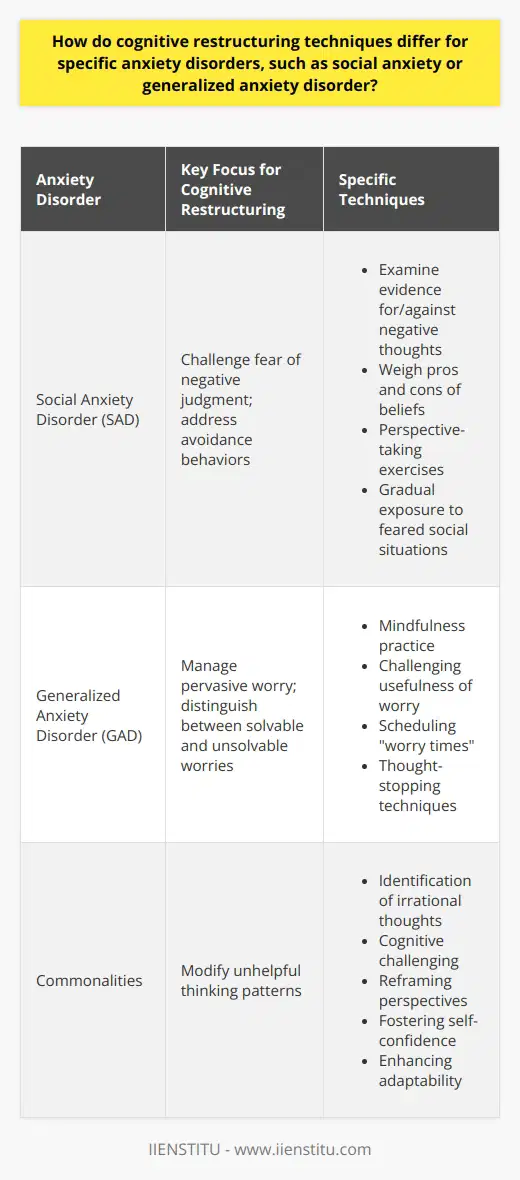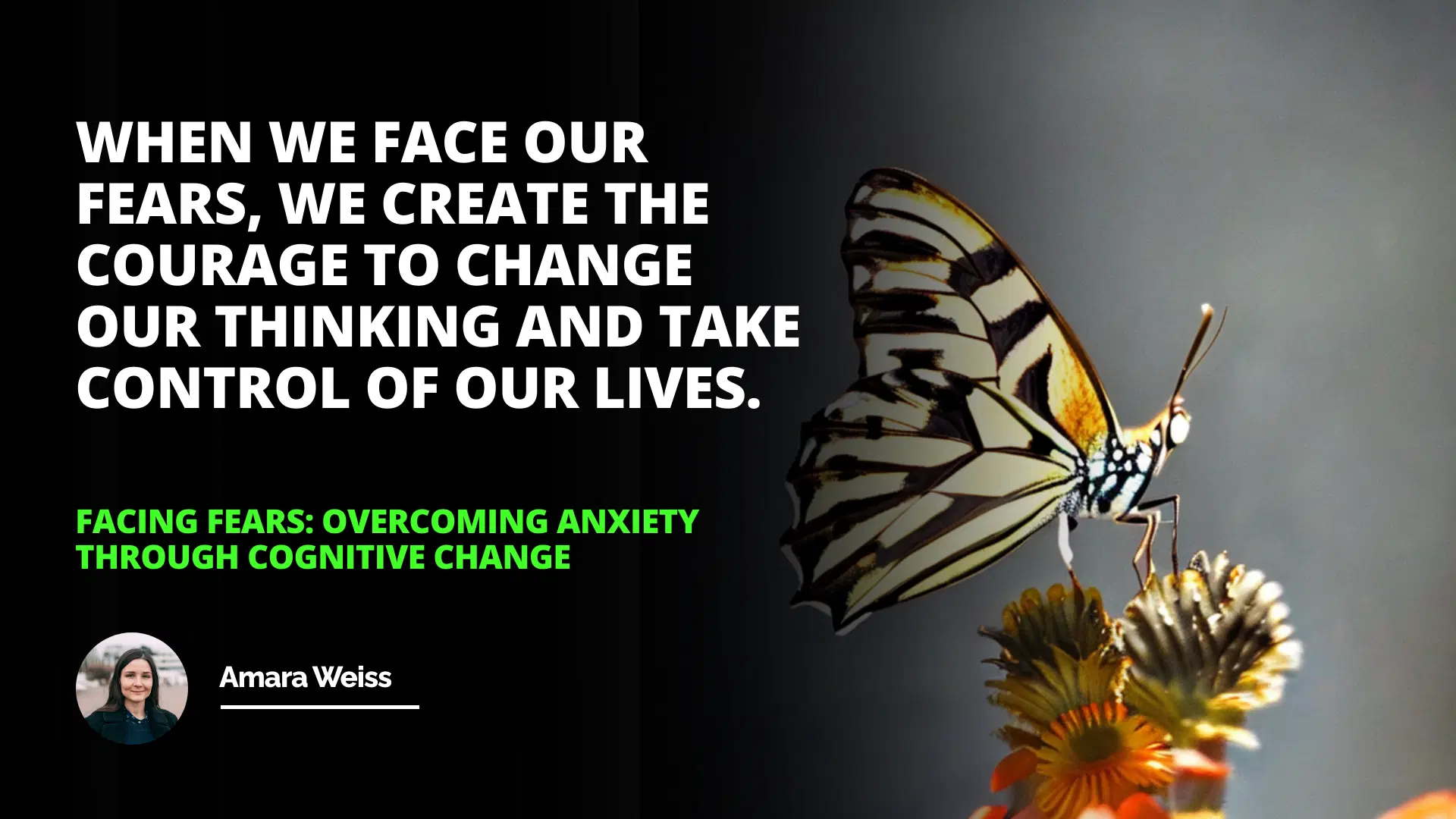
Signs and Symptoms of Anxiety
Understanding Cognitive Change
Practical Steps to Making Cognitive Change
Do you often feel overwhelmed, stressed, and anxious in life? Of course, it’s natural for people to experience fear and anxiety in certain situations. For some, however, anxiety can interfere with daily functioning and cause distress. This blog post explores the tension and explains how addressing our thought patterns through cognitive change can help us face and overcome our fears.
Signs and Symptoms of Anxiety
Anxiety can present in a variety of ways. Some common physical signs include restlessness, difficulty sleeping, difficulty concentrating, and increased heart rate. Emotionally, people may experience a sense of dread, worry, or panic when confronting particular situations. Some may even demonstrate avoidance behaviors to prevent facing their fears.
Understanding Cognitive Change
Cognitive change alters one’s thinking to produce different behavior in response to a situation. This type of therapy is based on the belief that our thoughts about a particular situation affect our emotional and physical reactions. Therefore, by modifying our thought patterns, we can work to reduce feelings of fear and anxiety.
Practical Steps to Making Cognitive Change
You can take several practical steps to begin the process of cognitive change. First, it is essential to examine our negative thought patterns. By questioning our thoughts, we can understand why we feel a certain way and how our thinking contributes to our anxiety. Once we know our thought patterns, we can challenge these limiting beliefs and practice new ways of thinking. Additionally, introducing relaxation techniques into our daily routines, such as deep breathing and mindfulness, can help to reduce anxiety.
In sum, activities that involve cognitive change can be a valuable tool to help us face and overcome our fears. Understanding negative thought patterns, challenging these beliefs, and practicing relaxation techniques can contribute to feeling less anxious in difficult situations. By mindfully addressing our thought patterns, we can address underlying sources of anxiety and learn to respond differently to potentially triggering concerns. Cognitive change has the potential to significantly improve our quality of life by allowing us to confront our fears and break down barriers that often hold us back from reaching our goals.
When we face our fears, we create the courage to change our thinking and take control of our lives.

Frequently Asked Questions
What techniques are used to combat anxiety through cognitive change?
Anxiety is an increasingly common psychological disorder associated with many physical and psychological symptoms. It can interfere with a person’s day-to-day life, causing significant distress. While medication and psychotherapy are commonly used treatments, some techniques can be used to combat anxiety through cognitive change.
Cognitive Behavioral Therapy (CBT) is a popular and effective technique used to help people manage anxiety. This psychotherapy approach focuses on developing adaptive strategies to challenge and change distress-related thinking styles and behaviors. It is based on the belief that cognitive factors such as thoughts, ideas, and assumptions can affect a person’s emotional state and ultimately result in their actions. Through this approach, individuals can identify and address distorted thinking patterns that can perpetuate anxiety, such as catastrophizing, black-and-white thinking, and rumination.
The Mindfulness-Based Stress Reduction (MBSR) technique is also widely used to reduce anxiety. Mindfulness practice involves being aware of one’s thoughts and emotions in the present moment without judgment or interpretation. Mindfulness promotes acceptance of one’s experiences to address issues and move past them rather than fixate on them. This approach can help to reduce symptoms of anxiety by promoting feelings of acceptance and self-compassion, as well as providing a more balanced perspective.
Cognitive Restructuring is another technique used to combat anxiety through cognitive change. This involves reframing disturbing thoughts by analyzing and questioning them. For example, people can be taught to challenge irrational thoughts and develop more balanced interpretations while considering potential outcomes and solutions to difficult situations. This approach can help reduce anxiety symptoms by replacing unhelpful and false beliefs with constructive ones.
Lastly, Relaxation Training is often employed to help reduce anxiety. This approach involves relaxation techniques such as deep breathing, progressive muscle relaxation, visualization, and mindfulness. These methods can help to lower the body’s physical arousal and improve a person’s ability to cope better with distress.
These techniques, among others, can be used to combat anxiety through cognitive change. People can develop self-awareness, acceptance, and emotional regulation by recognizing and addressing unhelpful thinking patterns and behaviors. This can help reduce anxiety symptoms and positively impact a person’s overall quality of life.

Is there different advice given for people with different levels of anxiety?
Anxiety is a complex disorder that affects many people in various ways. As such, people experience different anxiety levels, from mild to severe. Therefore, it is essential for those dealing with anxiety to be made aware of the advice best suited for their situation.
Many studies have been conducted to examine the efficacy of different forms of advice when it comes to alleviating anxiety. Generally speaking, it has been found that the advice given to an individual with a more severe form of stress may differ from that given to someone with a mild form. For example, a person with severe anxiety may be more likely to benefit from cognitive behavioral therapy (CBT) than someone who is only experiencing mild symptoms. On the other hand, someone with mild anxiety may be more likely to benefit from self-help strategies such as learning relaxation techniques, increasing physical activity, and exercising positive thinking.
In addition, advice tailored to each individual’s anxiety level may also help reduce the risk of relapse. For example, someone with severe anxiety may be encouraged to take a more aggressive approach to manage their symptoms, such as increasing their exposure to tense situations or challenging their fear-inducing thoughts. On the other hand, someone with mild anxiety may be guided to focus on management strategies such as making small changes in their lifestyle and setting realistic goals.
Overall, it is clear that people with different levels of anxiety will benefit from other kinds of advice. Therefore, it is crucial for health care providers to assess the severity of an individual’s anxiety symptoms and provide advice tailored to their needs.
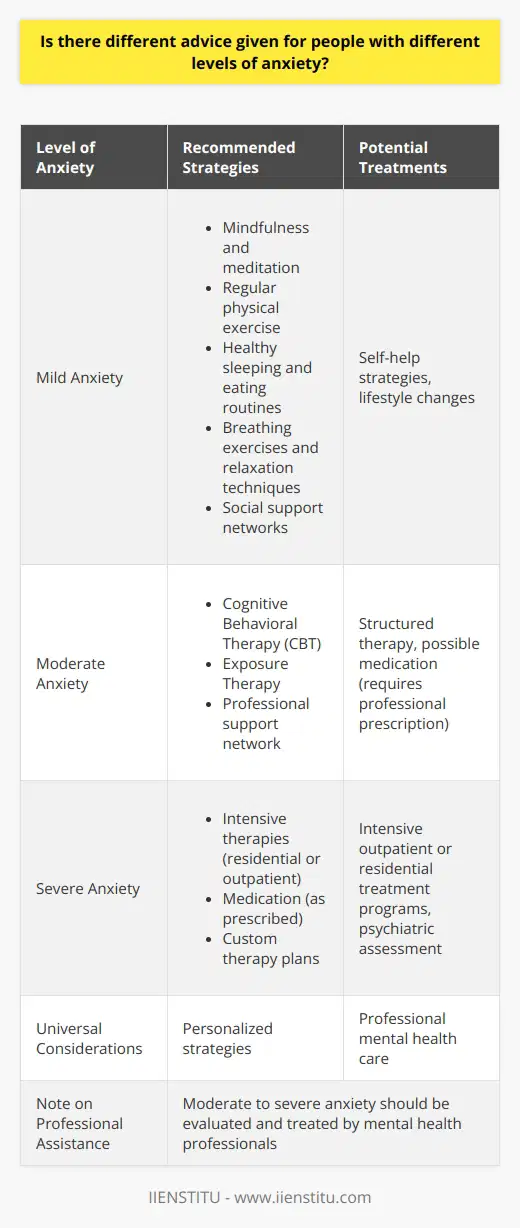
How can I assess whether cognitive change approaches are working for me?
Assessing whether cognitive change approaches work for individuals is essential in self-assessment and determining the methods' effectiveness. In this blog post, we will examine the various ways one may assess whether these approaches are working, leading to meaningful changes in behavior and well-being.
To assess the efficacy of cognitive change approaches, one should begin by looking at the short-term impact of the mental changes. Therefore, it is essential to track changes in behavior in the days immediately following the start of the approach. This could include measuring changes in energy levels, attitude, and general well-being. Additionally, mood logs can be kept to document changes in emotional states and perceptions of one's life satisfaction.
One should explore changes in values and goals over time to assess the longer-term effects of cognitive change approaches. This can be done through self-reflection and keeping track of the changes one wants or has made. It can also include taking notes when engaging in new activities and updating one's vision and mission in life. Additionally, one should measure changes in self-efficacy, confidence, and quality of life.
Ultimately, assessing whether cognitive change approaches are working requires a combination of self-reflection and charting the changes the individual is experiencing. By measuring both the mental and physical shifts, one can better understand the lasting impact of the approach and its efficacy. Together, these tools can provide insight into whether the system is working or changes need to be made.

What are the key principles involved in cognitive restructuring for managing anxiety?
Cognitive Restructuring for Anxiety Management
Understanding Cognitive Restructuring
Cognitive restructuring is a therapeutic technique that involves identifying and challenging irrational thoughts, beliefs, and cognitive distortions. It is often used in cognitive-behavioral therapy (CBT) to help individuals manage anxiety by altering unhealthy thought patterns.
Key Principles of Cognitive Restructuring
Identifying Cognitive Distortions
The first step in cognitive restructuring is to recognize distorted thought patterns that may trigger anxiety. Common cognitive distortions include catastrophizing, all-or-nothing thinking, and overgeneralization.
Logical Analysis of Thoughts
Next, individuals analyze their thoughts to determine whether they are logical, accurate, or based on evidence. For example, an anxious person may believe they will fail at an important task, but upon reflection, they may realize they have successfully completed similar tasks in the past.
Challenging Negative Thoughts
After identifying and analyzing thoughts, the individual works on challenging and replacing them with more accurate, rational thoughts. This might involve questioning the evidence for negative thoughts, looking for alternative explanations, or considering the possible outcomes of a situation.
Cognitive Reframing
Cognitive reframing involves changing the way individuals perceive a situation or emotion. For managing anxiety, this may mean shifting one's focus from the negatives to the positives and acknowledging personal strengths and resources that can help cope with anxiety.
Behavioral Activation
In addition to restructuring thoughts, cognitive restructuring also emphasizes the importance of engaging in activities that help reduce anxiety. This can include exercise, relaxation techniques, or exposure to anxiety-provoking situations in order to practice and apply new thought patterns.
Consistent Practice and Learning
Cognitive restructuring is a process that requires consistent practice and learning. Individuals must regularly monitor their thought patterns and apply the aforementioned techniques in order to develop healthier ways of thinking and managing anxiety.
In summary, cognitive restructuring aims to help individuals manage anxiety by identifying and challenging unhealthy thought patterns, analyzing thoughts logically, and replacing negative thoughts with more rational ones. This therapeutic technique also involves cognitive reframing, behavioral activation, and continuous practice for long-lasting change.
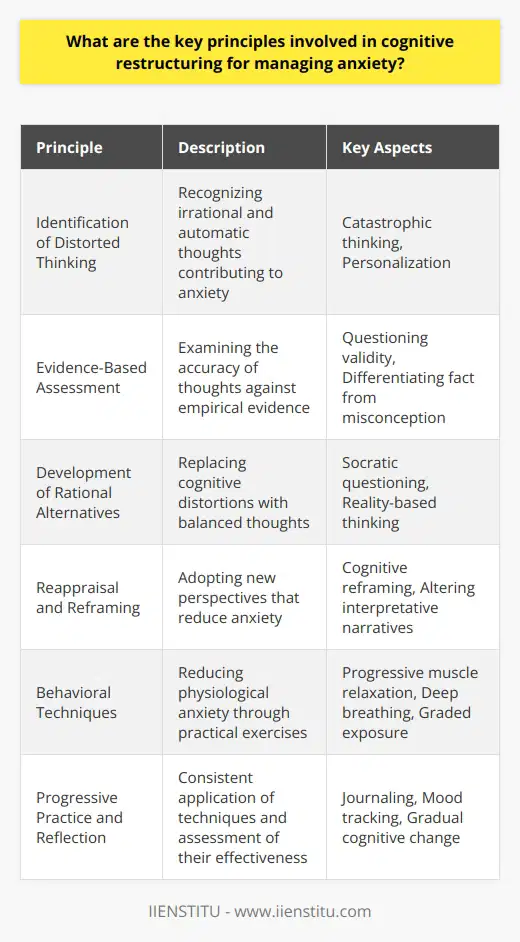
How can one effectively implement cognitive strategies to reduce anxiety in day-to-day life?
**Understanding Anxiety Reduction**
To effectively implement cognitive strategies for reducing anxiety in daily life, one must first understand anxiety's roots and manifestations. Anxiety stems from perceptions of threat, uncertainty, or vulnerability in the environment, causing a heightened stress response. Typically, anxious thoughts and behaviors result from individuals overestimating the likelihood and severity of negative outcomes in various situations.
**Cognitive Reframing Techniques**
One useful cognitive strategy is cognitive reframing, which involves adapting one's mental perspective to reinterpret anxiety-provoking situations in a less threatening manner. By challenging irrational beliefs and identifying cognitive distortions, such as all-or-nothing thinking, overgeneralization, and catastrophizing, individuals can develop more balanced and realistic views of events, thereby reducing anxiety levels.
**Mindfulness Practices**
The practice of mindfulness is another effective technique in managing anxiety. Mindfulness encourages individuals to focus on present experiences, rather than dwelling on past events or anticipating future problems. By engaging in activities like deep breathing, meditation, or progressive muscle relaxation, individuals can strengthen their ability to concentrate on the present moment and cultivate a greater sense of calm.
**Acceptance and Commitment Therapy**
In addition to cognitive reframing and mindfulness, acceptance and commitment therapy (ACT) can be a valuable approach for alleviating anxiety. ACT promotes psychological flexibility by helping individuals accept negative thoughts and feelings without judgment, rather than suppressing or avoiding them. By developing the ability to tolerate distressing emotions, individuals become more resilient to anxiety and better equipped to pursue valued goals.
**Healthy Lifestyle Choices**
Lastly, making healthy lifestyle choices can contribute to reduced anxiety. Regular exercise, proper nutrition, and adequate sleep not only improve overall physical health but also promote mental wellbeing. By engaging in self-care activities and maintaining a balanced lifestyle, individuals can better manage stress and decrease anxiety symptoms.
In conclusion, the implementation of cognitive strategies, such as cognitive reframing, mindfulness, acceptance and commitment therapy, and healthy lifestyle habits, can effectively reduce anxiety in daily life. The key to successfully employing these techniques lies in understanding anxiety's origins, recognizing its effects on thinking patterns, and taking intentional steps to cultivate mental resilience and well-being.
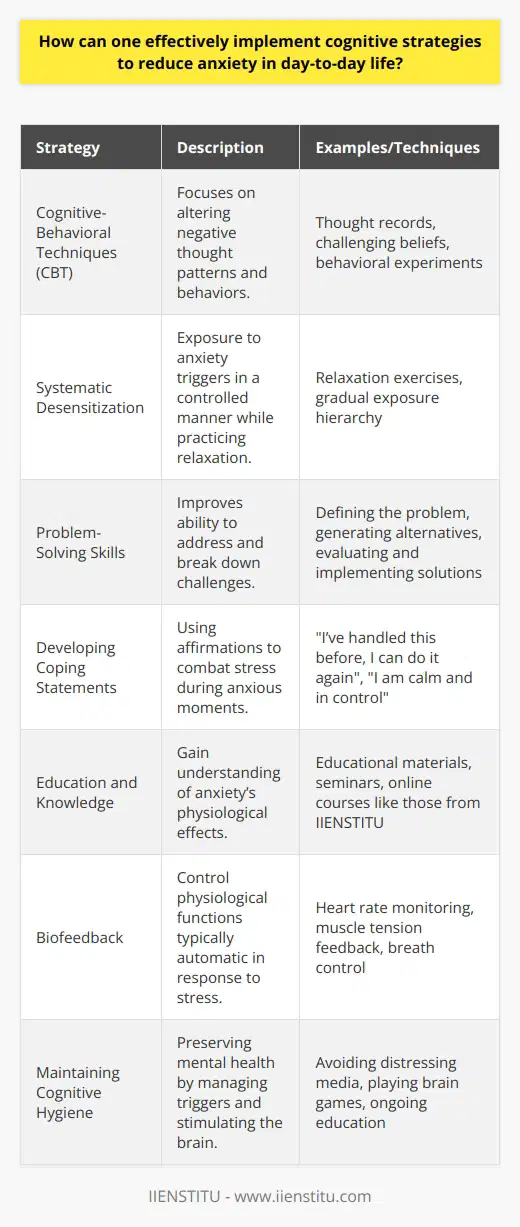
Can cognitive restructuring of fears contribute to long-term improvements in anxiety symptoms?
Cognitive Restructuring: A Valuable Tool for Managing Anxiety
Effectiveness in Addressing Fears
Cognitive restructuring, a core technique employed in cognitive behavior therapy (CBT), proves to be effective in altering maladaptive thought patterns and beliefs associated with fear and anxiety. By systematically identifying and challenging irrational or distorted thoughts, individuals learn to replace them with more accurate, adaptive interpretations of their experiences. This newfound ability to use logical, fact-based reasoning fosters a healthier mindset, alleviating the intensity and frequency of anxiety symptoms.
Sustainability of Long-term Improvements
The long-term benefits of cognitive restructuring on anxiety symptoms can be observed through its mechanism of action, empowering individuals with the essential skills to manage their thoughts independently. As individuals become proficient in recognizing the onset of negative thoughts and reframing them, they develop resilience to tension and stressors. Furthermore, ongoing practice consolidates and reinforces this skillset, enabling individuals to sustain the improvements in anxiety management over time effectively.
Support from Clinical Research
Numerous research studies substantiate the long-term efficacy of cognitive restructuring in ameliorating anxiety symptoms. A meta-analysis by Hofmann and Smits (2008) demonstrates that CBT, including cognitive restructuring, yields substantial improvements in anxiety symptoms and maintains these benefits long after treatment termination. Additionally, long-term follow-up studies conducted by Durham et al. (2003) and Clark et al. (2006) indicate that the therapeutic gains achieved through cognitive restructuring can last up to 10 years or more in some cases.
Conclusion
In conclusion, cognitive restructuring of fears indeed contributes to substantial and enduring improvements in anxiety symptoms. As a fundamental component of CBT, it equips individuals with the necessary skills to regulate their thoughts and to counter the adverse effects of fear and anxiety effectively. The long-term success of cognitive restructuring is well-documented in clinical research, attesting to its efficacy as a powerful therapeutic tool for addressing anxiety disorders.
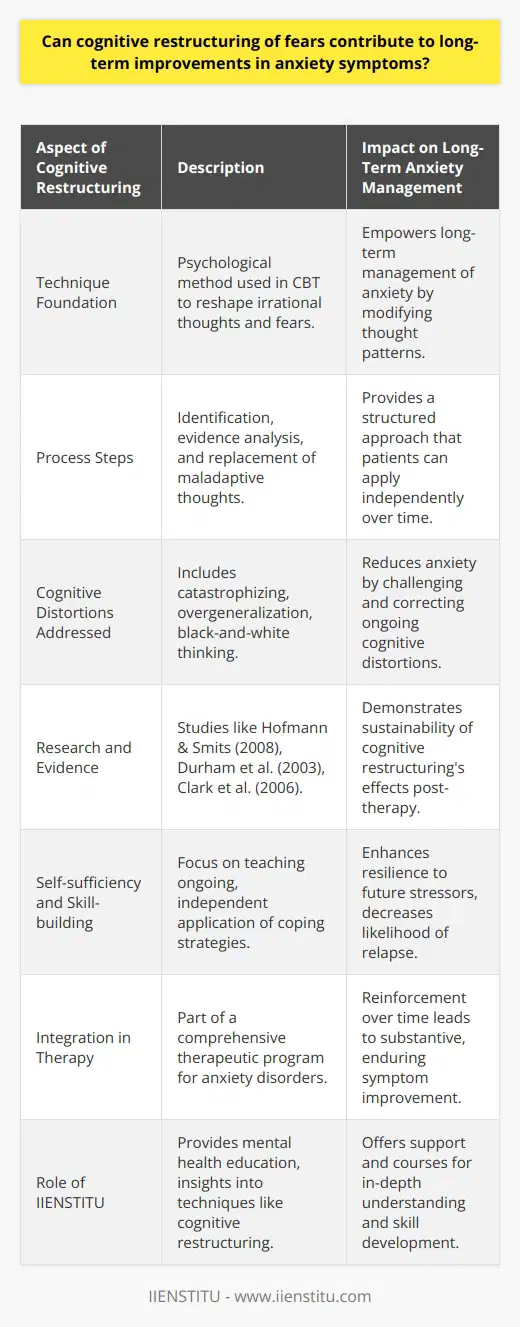
What are the underlying mechanisms of cognitive restructuring in alleviating anxiety?
Mechanisms of Cognitive Restructuring
Cognitive restructuring, a key component of cognitive-behavioral therapy (CBT), assists individuals in alleviating anxiety through various underlying mechanisms. These mechanisms include identifying and modifying irrational beliefs, enhancing emotional regulation, and promoting adaptive coping strategies.
Identifying and Modifying Irrational Beliefs
Cognitive restructuring primarily involves identifying an individual's maladaptive thought patterns and facilitating the process of reevaluating these thoughts in order to create more balanced and rational interpretations of events. In the context of anxiety, irrational beliefs often take the form of catastrophizing, overgeneralizing, and mental filtering. Through targeted questioning and self-reflection, individuals become more aware of these thought distortions and are able to challenge them effectively, leading to reduced anxiety levels.
Enhancing Emotional Regulation
Another mechanism through which cognitive restructuring aids in anxiety reduction is the improvement of emotional regulation skills. By modifying irrational thoughts and shifting cognitive perspectives, individuals experience changes in their emotional responses to anxiety-provoking situations. Gaining control over one's emotions is crucial for managing anxiety, as it allows individuals to effectively manage their emotional reactions and prevent feelings of overwhelm or panic.
Promoting Adaptive Coping Strategies
Lastly, cognitive restructuring fosters the development and implementation of adaptive coping strategies that decrease anxiety. As individuals recognize and restructure their irrational thoughts, they also learn to respond to anxiety-provoking situations in more constructive ways. These adaptive coping strategies may include problem-solving, assertiveness training, or relaxation techniques. By replacing maladaptive thoughts and behaviors with healthier alternatives, individuals are better equipped to manage their anxiety levels in the long term.
In conclusion, cognitive restructuring plays a significant role in alleviating anxiety by targeting the underlying mechanisms of identifying and modifying irrational beliefs, enhancing emotional regulation, and promoting adaptive coping strategies. By focusing on these key areas, cognitive restructuring equips individuals with the necessary tools to understand and manage their anxiety in a more efficient and effective manner.
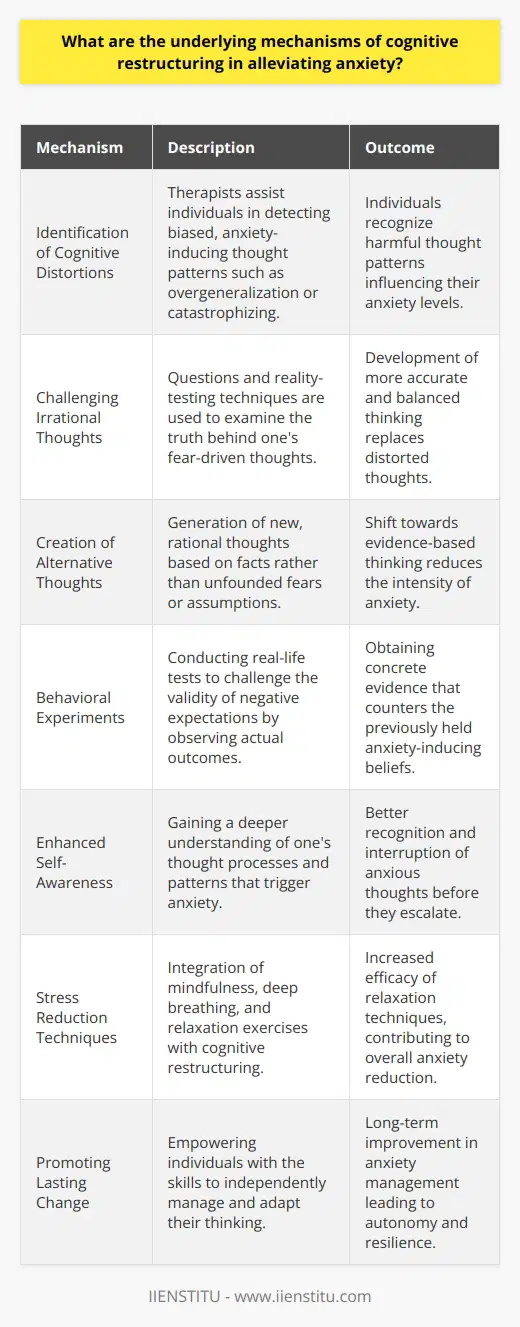
Can cognitive restructuring for anxiety be combined with other therapeutic techniques?
Integration of Techniques
Indeed, cognitive restructuring for anxiety can be combined with other therapeutic techniques to effectively relieve anxiety symptoms. Cognitive restructuring, derived from cognitive-behavioral therapy (CBT), focuses on identifying and altering maladaptive thought patterns to reduce anxiety. By acknowledging these negative thoughts, individuals can replace them with healthier, more adaptive ways of thinking.
Incorporating Relaxation Techniques
One common complementary technique is relaxation training, which aims to reduce anxiety by promoting physical and mental relaxation. Examples of relaxation techniques include deep breathing, progressive muscle relaxation, and guided imagery. These methods can be taught in conjunction with cognitive restructuring, allowing individuals to manage their anxiety by addressing both their cognitive and physiological symptoms.
Exposure Therapy
Another technique that can be combined with cognitive restructuring is exposure therapy. Exposure therapy involves gradually confronting anxiety-provoking situations, fostering habituation and ultimately reducing anxiety. When combined with cognitive restructuring, this approach can enable individuals to examine their distorted beliefs about the feared situation and gain a more rational understanding of their anxiety. Consequently, exposure therapy provides opportunities for individuals to test and reinforce their newly acquired cognitive coping strategies in real-life situations.
Acceptance and Commitment Therapy
Lastly, acceptance and commitment therapy (ACT) can also be integrated with cognitive restructuring. ACT principles encourage individuals to accept unpleasant thoughts and feelings as temporary, unavoidable experiences. Rather than attempting to control these thoughts, individuals can choose more helpful actions that align with their values. By combining ACT elements with cognitive restructuring, individuals can develop nuanced cognitive coping strategies that encompass both dispute and acceptance of anxiety-provoking thoughts.
Overall, integrating cognitive restructuring with other therapeutic techniques such as relaxation training, exposure therapy, and acceptance and commitment therapy can provide a comprehensive treatment approach for anxiety. By offering diverse strategies to manage anxious thoughts and physiological responses, these combined therapeutic techniques can enable individuals to better cope with and overcome their anxiety.
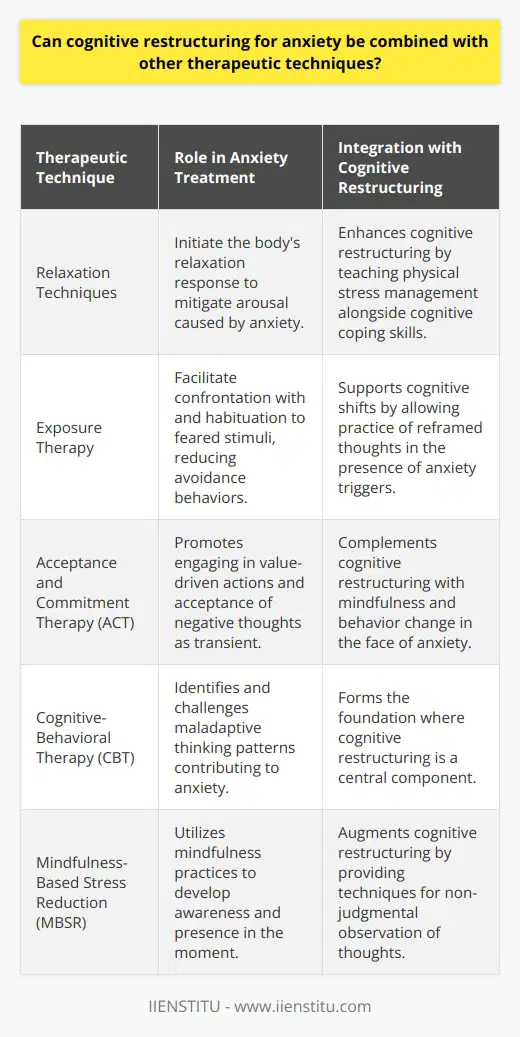
To what extent does the efficacy of cognitive restructuring depend on individual differences in anxiety?
Individual Differences in Anxiety
Cognitive restructuring, a core element of cognitive behavioral therapy (CBT), can be highly effective in treating anxiety disorders. However, its efficacy may largely depend on individual differences in anxiety levels and the nature of the anxiety condition. This notion raises the question: To what extent does the efficacy of cognitive restructuring depend on individual differences in anxiety?
Severity of Anxiety Symptoms
One factor to consider is the severity of anxiety symptoms. People experiencing severe symptoms might find it challenging to engage with cognitive restructuring techniques initially. In such cases, adjunctive treatments like medication or relaxation techniques may be needed to decrease symptom intensity before cognitive restructuring can be optimally effective.
Cognitive Biases and Thinking Patterns
Another relevant factor is the presence of cognitive biases and thinking patterns among individuals. Different individuals may exhibit varying degrees of cognitive distortions, affecting the ease with which they can modify established thought patterns. Those with deeply ingrained negative beliefs might require more time and effort to adapt to new cognitive perspectives.
Ability to Accept and Adopt Change
Additionally, individuals' ability to accept and adopt change can influence the success of cognitive restructuring. People resistant to change or skeptical about the effectiveness of cognitive restructuring might find it harder to benefit from the intervention. On the other hand, those open to self-examination and changing thought patterns could experience greater improvements in anxiety symptoms.
Coping Skills and Resilience
Coping skills and resilience also play significant roles in cognitive restructuring efficacy. For individuals with strong coping strategies and high resilience, cognitive restructuring might be more effective for managing anxiety. Conversely, those lacking such abilities might find it difficult to integrate and apply the techniques learned in therapy.
Therapeutic Alliance
Finally, the strength of the therapeutic alliance between the individual and therapist can be a deciding factor in the success of cognitive restructuring. When individuals feel supported and understood by their therapists, they are more likely to feel comfortable discussing difficult thoughts, thereby facilitating more effective cognitive restructuring.
In conclusion, cognitive restructuring's efficacy in treating anxiety disorders is dependent on individual differences in factors such as symptom severity, cognitive biases, acceptance of change, coping skills, and the strength of the therapeutic alliance. It is crucial for therapists to consider these factors when tailoring personalized mental health interventions for individuals with anxiety.

What are the cognitive processes involved in transforming anxiety-provoking thoughts through cognitive restructuring?
Cognitive Processes in Cognitive Restructuring
Cognitive restructuring is a therapeutic technique employed to modify maladaptive thought patterns and replace them with more adaptive ones. The goal is to minimize anxiety symptoms and improve overall mental health. Transformation of anxiety-provoking thoughts relies on several cognitive processes, including cognition, metacognition, and memory.
Cognition and Thought Identification
Central to cognitive restructuring is the ability to identify and challenge negative thoughts. This requires the cognitive process of cognition or conscious mental activities, including perception, reasoning, and judgment. Clients must first recognize their thought patterns and identify those that are maladaptive or anxiety-evoking.
Metacognition and Thought Analysis
Once the negative thoughts are identified, clients employ metacognition, or thinking about one's thought patterns. This process enables individuals to examine the evidence supporting their thoughts, determine their accuracy, and assess their impact on emotional well-being. In this stage, clients analyze their thought patterns to identify cognitive distortions, such as catastrophizing, polarization, or overgeneralization, which contribute to anxiety.
Memory and Thought Replacement
Cognitive restructuring requires accessing and altering one's memory. Clients need to recall instances when the anxiety-provoking thought was inaccurate or exaggerated. This helps form new, more adaptive thoughts to replace the negative ones. Memory retrieval and restructuring allow the individual to learn from past experiences and apply these insights to current situations, reducing anxiety.
Cognitive Rehearsal and Reassertion
To solidify the transformation of thoughts, clients practice cognitive rehearsal, mentally repeating the new, adaptive thoughts. They also engage in cognitive reassertion, a process of reaffirming their belief in the new thoughts. These processes reinforce the replacement of maladaptive thoughts and promote a healthy cognitive outlook.
In conclusion, cognitive restructuring relies on a combination of cognitive processes, including cognition, metacognition, memory retrieval, and cognitive rehearsal. Through these processes, individuals can learn to identify negative thoughts, analyze their validity, and replace them with more adaptive beliefs. In turn, this reduces anxiety symptoms and enhances overall mental health.
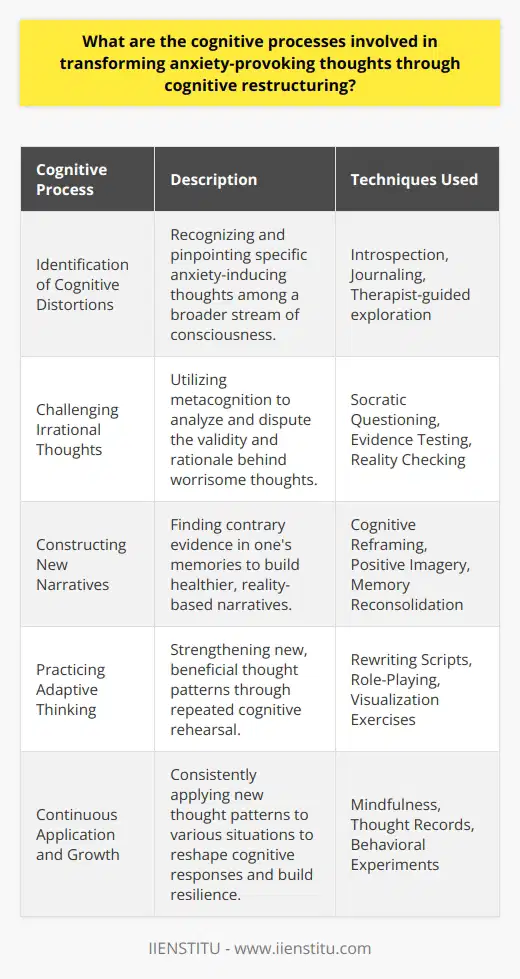
In what contexts is cognitive restructuring most effective for alleviating anxiety symptoms?
Contexts for Effective Cognitive Restructuring
Cognitive restructuring is a psychological technique that aims to facilitate the identification and challenge of distorted thoughts or beliefs, ultimately leading to a reduction in anxiety symptoms. Research has demonstrated that cognitive restructuring is most effective in alleviating anxiety symptoms within specific contexts, including when treating anxiety disorders, managing work-related stress, and addressing performance anxiety.
Treating Anxiety Disorders
One primary context where cognitive restructuring has demonstrated efficacy is in the treatment of anxiety disorders, such as generalized anxiety disorder, social anxiety disorder, and panic disorder. In these clinical conditions, individuals often have maladaptive thought patterns and beliefs that contribute to excessive anxiety. By identifying and altering these cognitive distortions, individuals can experience a significant reduction in anxiety symptoms and an improvement in overall mental health.
Managing Work-Related Stress
Work-related stress is a common source of anxiety for many individuals. Cognitive restructuring techniques can be an effective method to manage anxiety within this context as well. By addressing negative thought patterns and beliefs about work situations, individuals can develop a more balanced and adaptive perspective, leading to reduced anxiety and better job satisfaction. For example, changing a thought like 'I will fail if I don't complete this task perfectly' to 'It's okay to ask for help or to make mistakes, as that's how I can learn and grow' can help alleviate anxiety related to work performance expectations.
Addressing Performance Anxiety
Performance anxiety, often experienced by athletes, musicians, and public speakers, is another context where cognitive restructuring can have significant benefits. In these situations, individuals may have distorted thoughts and beliefs related to their abilities or the consequences of their performance. Challenging and changing these thoughts can lead to a more accurate assessment of their skills, increased self-confidence, and ultimately, a reduction in anxiety. For instance, shifting the focus from the fear of failure or embarrassment to an emphasis on the enjoyment and mastery of the task can create a more positive mindset, reducing performance anxiety.
In conclusion, cognitive restructuring is a valuable approach for alleviating anxiety symptoms in various contexts, such as treating anxiety disorders, managing work-related stress, and addressing performance anxiety. By targeting distorted thoughts and beliefs, individuals can reduce their anxiety and develop a more adaptive and healthy outlook on life.

How do cognitive restructuring techniques differ for specific anxiety disorders, such as social anxiety or generalized anxiety disorder?
Cognitive Restructuring in Anxiety Disorders
Cognitive restructuring, a core component of cognitive-behavioral therapy (CBT), focuses on identifying and modifying dysfunctional thought patterns to alleviate symptoms of anxiety. However, the application of cognitive restructuring techniques for specific anxiety disorders, such as social anxiety disorder (SAD) and generalized anxiety disorder (GAD), incorporates distinctive variations according to the unique characteristics of each disorder.
Addressing Fears of Negative Evaluation in Social Anxiety
In SAD, the primary focus of cognitive restructuring is to counter distorted thoughts related to the fear of negative evaluation by others. The therapist assists the patient in identifying irrational beliefs and cognitive distortions, such as overgeneralization, catastrophizing, and personalization. Challenging these distorted thoughts with more balanced, rational perspectives leads to a reduction in anxiety during social situations. Moreover, the therapist encourages the patient to engage in cognitive exposures through gradual confrontation of anxiety-provoking situations and regular practice of cognitive restructuring techniques.
Examining Worry Patterns in Generalized Anxiety Disorder
For GAD, cognitive restructuring techniques target the persistent, excessive worry often centered around multiple aspects of life. The therapist helps the patient identify and challenge their worry patterns, particularly their beliefs about the usefulness and uncontrollability of worry. This may involve modifying core beliefs associated with uncertainty intolerance and faulty problem-solving strategies. Guided practice of mindfulness and acceptance techniques further supports the process of cognitive restructuring in GAD patients by enhancing their ability to regulate worry and reducing the intensity of anxiety symptoms.
Adjusting to Specific Anxiety Disorder Needs
In conclusion, while cognitive restructuring techniques share a common goal of modifying maladaptive thought patterns, their application varies significantly based on the specific anxiety disorder. The focus on fears of negative evaluation and cognitive exposures in SAD treatment helps individuals build confidence in social situations, while addressing worry patterns, uncertainty intolerance, and acceptance in GAD treatment aims to reduce the constant cycle of worry and anxiety. Recognizing these differences and tailoring interventions accordingly is vital for the successful treatment of anxiety disorders using cognitive restructuring techniques.
